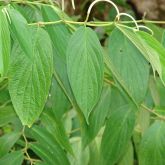Spiked pepper
Alert
Have you seen Spiked pepper?
Be on the lookout for Spiked pepper and report it to Biosecurity Queensland. Early detection and reporting are the key elements in preventing Spiked pepper from becoming a major problem in Queensland.
Call us on 13 25 23.

Spiked pepper leaves
© F & K Starr Creative Commons

Spiked pepper infestation
© F & K Starr Creative Commons

Spiked pepper bush
© F & K Starr Creative Commons

Spiked pepper in undergrowth
© Queensland Government

Spiked pepper large infestation
© F & K Starr Creative Commons

Spiked pepper leaves close-up
© Queensland Government
Native to South and Central America, spiked pepper is a fast-growing tropical shrub that has become a serious invasive plant in Papua New Guinea and other Pacific and South-East Asian countries. It is poisonous to cattle and can exclude native plants.
You must take reasonable action to minimise the risk of spreading Spiked pepper to ensure the situation isn't worsened.
You must report all sightings to Biosecurity Queensland within 24 hours.
Scientific name
Other names
- Spiked piper, bamboo piper
Description
- Shrub or small tree up to 8m high and up to 10cm or more in stem diameter.
- Alternate leaves have short petioles and elliptic to lanceolate blades 12–20cm long.
- Spikes contain minute flowers that develop into imbedded drupes (fruits) with brown or black seeds.
- Peppery taste and odour.
Habitat
- Prefers rainforests, roadsides, waterways, plantations and pasture.
Distribution
- Not known to exist in Queensland but has potential to become a serious problem if introduced and planted.
Life cycle
- Flowers and fruits throughout the year.
Affected animals
- Cattle
Impacts
Environmental
- Forms infestations that exclude all native vegetation.
Economic
- Poisonous to cattle.
Prevention
Control
- Before undertaking any preventative or control actions, contact our Customer Service Centre.
Legal requirements
- Spiked pepper is a prohibited invasive plant under the Biosecurity Act 2014.
- You must not keep, move, give away, sell or release into the environment. Penalties may apply.
- You must not take any action reasonably likely to exacerbate the biosecurity threat posed by spiked pepper.
- You must take any action that is reasonably likely to minimise the biosecurity threat posed by spiked pepper.
- You must report all sightings to Biosecurity Queensland within 24 hours.